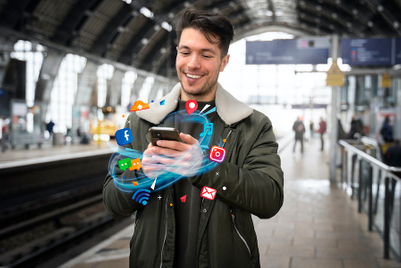
“You have the attention span of a goldfish.” Remember saying this to a friend who couldn’t pay attention to what you were saying for more than a few seconds? Well, research has now shown that it’s true for most of us when we’re on our mobiles, which means it’s likely to be true most of the time.
According to data from the Statistic Brain Research Institute, goldfish have an attention span of nine seconds, while the average human attention span has gone down by 33 percent since the year 2000 to just 8.25 seconds in 2015. So these days, goldfish could say, “You have the attention span of a human”!
Why this matters to marketers
This matters to marketers in Southeast Asia (SEA) because smartphones and social media have given rise to mobile-first consumers who now spend more time interacting with their mobile screens than looking at TV. For instance, Millward Brown’s AdReaction study shows that consumers in Indonesia spend 107 minutes per day on their mobiles compared to 74 minutes watching TV. The same pattern is repeated across SEA. So as far as marketers in SEA are concerned, we might as well be advertising to goldfish! To get the attention of our goldfish audience, we need to unlearn the habits of both 30-second ads designed for TV screens as well as two-minute-plus video ads designed for desktop computers.
The good news is that there are new strategies and tools available to create effective mobile-first content.
Advertising rules meet human computer interaction
When creating ads or branded content, combine two approaches: the 'ABCDs' of advertising with the 'four Is' of human computer interaction on mobile.
The current best practices in advertising and brand storytelling often don’t work on mobile because they are based on decades of research into the passive medium of television. Successful mobile-first marketing requires the combination of classic, media-agnostic advertising rules with insights from the field of human-computer interaction.

Combining the two, we get the ABCD rules of mobile-first advertising:
- Attention: Grab it through low interaction-cost tools like autoplay, which require no user action, or hyperlapse, which leverages the human survival instinct of focusing on rapid movement.
- Branding from the first second. This signals importance and relevance. Also, people may not watch long enough to notice logos/branding that appear late in the video.
- Communicate without sound. Use subtitles, as many mobile ads are viewed with the sound off. Zoom in on key frames for the smaller screen.
- Deliver the message instantly, within the first few seconds—10 seconds at most. The goldfish rule!
Is 10 seconds the right length for video ads on mobile?
While researching human attention spans online, the consumer insights group at Microsoft Canada has found that long-term focus erodes with increased digital consumption, social-media usage, and tech savviness with 19 percent of online viewers losing interest in the first 10 seconds.
Is this really new news? In 2011, Jakob Nielsen, one of the world’s leading experts in digital user experience design for web pages, found that to gain user attention, “you must clearly communicate your value proposition within 10 seconds.”
The latest meta-analysis of 173 brand effect studies by The Nielsen Company (not related to Jakob Nielsen) has found that 10 seconds is the sweet spot for brand impact created by video ads on Facebook.
Commuting time is mobile prime time in Southeast Asia
4.3 hours. That’s the average commuting time for people in some of Asia’s most dynamic mega-cities: Jakarta, Bangkok, Manila and Kuala Lumpur. A quick glance inside the buses, trains, vans and jeepneys that ferry people from home to work and back show that most people pass the time scanning social media on their mobile phones.
For these people, the morning and evening commuting times are the new prime time. This is a great opportunity for marketers to reach them with relevant content, including both short and long-form content. Many people do last-minute shopping on their way home, so advertising during mobile prime time is more likely to stimulate purchase than traditional TV advertising.
Although your audience has time to kill, remember they are scrolling quickly looking for a content fix to keep them entertained. Microsoft’s research shows that the thrill of finding something new often makes connected consumers jump off one experience into another. It’s up to you to grab their attention and hold it.
Shorter attention spans, swifter path to purchase
Shorter attention spans are impacting the path to purchase on mobile. More than 60 percent of those who begin the journey towards an e-commerce website fail to arrive at the destination. That’s because people don’t have the patience to follow the digital trail of breadcrumbs all over the internet.
Consider a typical high-involvement purchase like a smartphone. The consumer is less likely to visit the brand’s website, but more likely to seek a professional tech site’s comparison with other brands, user reviews from a consumer forum, pricing information from a price comparison website and even then, may wait for a promotional offer before making the final purchase. At each stage, the goldfish audience might get bored or distracted and the path to purchase is broken.
Research by Telmetrics and xAd shows that mobile ads have the potential for immediate action, with 47 percent of people taking some action and 25 percent of them making a purchase. At least 38 percent search for more information after seeing ads. The challenge for marketers is to bring that information to people within the ad itself and to maximize the number of people making a purchase after seeing the ad.
To do this, marketers should collect and bring all the relevant information to consumers in one place. For example, a typical Carousel ad on Facebook has five frames, which can be used for photo or video content. These could include an attention-grabbing visual of the camera, the tech site’s comparison, a video of an actual user review, a price-comparison image and a call to action “Buy Now” button with a promotional offer in the final frame.

Reaching real people, not statistical ghosts
Traditional media as well as some digital media are full of ghost audiences: viewers who don’t exist. In the case of TV, this is because traditional television rating panels sample a small number of households, assume that everyone in the household is watching and project these assumptions to a national scale.
A meta-analysis of cross-media studies done by Millward Brown in APAC found that mobile-first media like Facebook deliver up to two times the ROI of TV, as measured by impact per dollar spent on generating awareness, association and purchase motivation. Mobile ads on Facebook are far more effective because real identity data enables relevant, personalized advertising that’s shown to real people, not to statistical projections.
With data on real people, marketers can gain better insight into what their consumers’ individual preferences are and deliver them content relevant to them, which means you’re more likely to hold their attention for a longer period of time. Marketers can also use sophisticated data-based approaches to find new, unexpected sources of growth for their brands.
Fish where the goldfish are
People in Southeast Asia are either mobile-first or increasingly mobile-only. Marketers can reach real people with relevant ABCD content, during mobile prime time, giving them an instant path to purchase. The majority of consumers in Southeast Asia have made the shift to mobile and it’s now time for marketers to do the same.
Reynold D’Silva is group head for FMCG, tech, telco and media brands at Facebook Southeast Asia





.jpg&h=334&w=500&q=100&v=20250320&c=1)
.jpg&h=334&w=500&q=100&v=20250320&c=1)
.jpg&h=334&w=500&q=100&v=20250320&c=1)



.png&h=334&w=500&q=100&v=20250320&c=1)

.png&h=334&w=500&q=100&v=20250320&c=1)








